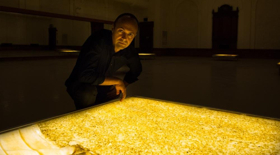Interview: Otero-Pailos Captures Merce Cunningham in Dust at New York City Center

New York City Center's 75th Anniversary Season features an abundance of outstanding programming from the 15th Fall for Dance Festival to Alvin Ailey American Dance Theater's Anniversary celebration to a gala presentation of Broadway hit A Chorus Line to Balanchine: The City Center Years featuring the best ballet companies in the world.
Jorge Otero-Pailos is one of three artists who have been selected to capture the season in City Center's first-ever series of visual art commissions. Working at the intersection of art, architecture, and preservation Otero-Pailos has been exhibited by major art institutions such as the 53rd Venice Art Biennial and the Louis Vuitton Galerie Museum as well as within landmark sites such as Westminster Hall in London and the Doge's Palace in Venice.
Otero-Pailos has created Répétiteur for New York City Center. The installation explores how the choreography of dance masters is passed from generation to generation. The work draws attention to the only material evidence dance leaves behind-the dust, and other residue, left by the dancers, on the surfaces of the practice room. The accompanying sound collage includes the rehearsal clamor of dancers learning Merce Cunningham from his various répétiteurs.
City Center's Harkness Studio will be home to illuminated, latex sculptures that capture the dust from 10am to 6pm on October 15th through 21st of this year; March 2nd through 10th and April 29th through May 5th in 2019. An opening reception will take place on October 16th from 5pm to 7pm.
BWW: What inspired Répétiteur?
Otero-Pailos: New York City Center's legendary studios gripped me. They were originally built as part of the temple of the Shriners, an appendage of Freemasonry. I became interested in the rituals that take place in the dance studios today, in particular the rituals of transmitting dances from one generation to the next. I wanted to create work that expressed that transmission process, which is how dance endures in spite of its ephemerality.
BWW: The sounds of répétiteurs teaching Merce Cunningham's choreography can be heard throughout the exhibit. Could you tell us a bit more about that?
Otero-Pailos: The survival of old dances depends on the répétiteurs, the people who re-stage dances. Yet these vital figures are completely unknown outside the dance world. The work of the répétiteurs is paradoxical-if they do their job well, they disappear. They present you with say Merce Cunningham's dance, and not their own. My artwork calls attention to these figures in a way that is consistent with their invisibility. That's why I used sound. When you enter the studio, the répétiteurs' presence is everywhere, and yet they are invisible.
BWW: What was the appeal of Merce Cunningham for you?
Otero-Pailos: Cunningham carefully considered the role of sound in dance. He famously rejected synchronizing dance to music. It's very difficult to keep time without an external measure like music. Yet Cunningham demanded that dancers keep exact timings. I became interested in how, in the absence of music, dancers use sound as a measure of time. They make rhythmic sounds with their bodies, stomping or rubbing their feet on the floors of the dance studio. They hear each other dance to keep in synch. They don't look. The répétiteur counts out loud, claps, speaks rhythmically and so on. In the practice studio you can hear the rhythm of bodies keeping time. In the main theater, the sound is so distant that dance can really only be experienced visually. I also thought it was special that, in addition to City Center's 75th year, it's been 100 years since Merce Cunningham's birth.
BWW: Why dust?
Otero-Pailos: The installation includes dust that I peeled from the walls of studio using latex sheets. The peelings are shown in six light boxes on the floor of the dance studio. They make a hexagram, in reference to Cunningham's use of hexagrams from The I Ching to introduce chance in his choreographies.
Like sound, dust is a measure of time. Whereas sound helps us measure short segments of time, dust allows us to measure very long spans of time. For example, we say "dust to dust" to refer to an entire lifetime. The dust in the studio accumulates over time. It comes from the labor of dancers, their sweat, skin, hair and so on. By using sound and dust, I wanted to express the tension and contradictions between the short ephemerality of dance, and the long chain of laboring dancers working to preserve Cunningham's famous dances indefinitely.
BWW: Explain the process for incorporating the dance world into your work. Were there any challenges?
Otero-Pailos: The main challenge was to give a representation of dance that didn't depend on movement. That led me to experiment with including sound alongside dust for the first time, which is very exciting.
New York City Center's Harkness studio is located at 130 W. 56th street in Manhattan. Please visit www.NYCityCenter.org/VisualArt for more information. For more on Jorge Otero-Pailos please visit www.OteroPailos.com.
Photo by Paula Lobo
Comments

Videos

